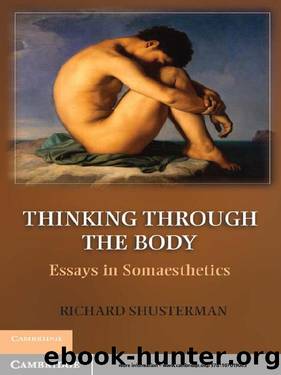Thinking Through the Body by Richard Shusterman

Author:Richard Shusterman [Shusterman, Richard]
Language: eng
Format: epub
Tags: Politics & Social Sciences, Philosophy, Consciousness & Thought, Movements, Humanism
ISBN: 1107019060
Amazon: B009ND51R2
Publisher: Cambridge University Press
Published: 2012-07-15T21:00:00+00:00
VI
I am, however, unwilling to accept his rejection of somaesthetics. So let me conclude by first considering his critique and then showing how somaesthetics effectively serves the key functions that Rorty demands of philosophy as cultural politics. Despite his continued insistence that “all awareness is a linguistic affair,” Rorty concedes to me and somaesthetics that we can experience and create things that allow us to “revel, however briefly, in nondiscursive sensual joy.”28 However, he questions the idea of somaesthetics as a project or “programme” that, by thinking through the body and working on it, could bring more of this nondiscursive joy and more understanding of how it is achieved, experienced, and deployed in our lives. More precisely, he challenges somaesthetics by assimilating it into traditional aesthetic theory of the Kantian variety that aims to isolate a pure aesthetic essence that defines all things aesthetic and differentiates them from everything else. Rorty doubts we “need ‘a somatic aesthetics,’” because we do not “need an aesthetic theory, or an aesthetic programme, at all.” And he immediately supplies the anti-essentialist reason for his skepticism: “I doubt there is much to be said about what unites painting, literature, music, sex, and birdwatching while distinguishing all these from science, morals, politics, philosophy and religion” (RRS, 156).
I share Rorty's resistance to the essentialism of traditional aesthetics, and I even criticize our hero Dewey for courting it too closely.29 However, “scepticism about ‘aesthetics’ as a field of inquiry” in its traditional essentialist sense, which Rorty calls “another of Kant's bad ideas” (RRS, 156), has no relevance to the somaesthetic project, which could not be farther from an attempt to define and compartmentalize a pure aesthetic domain. Somaesthetics is instead a distinctively interdisciplinary enterprise, radiating out of the concept of soma – the living, feeling, sentient, purposive body that implies the essential union of body-mind. The somaesthetic program – of studying the ways we use our soma in perception, performance, and self-fashioning; the ways that physiology and society shape and constrain those uses; and the methods we have developed or can invent to enhance those uses and provide newer and better forms of somatic awareness and functioning – implies engaging with science, morals, politics, art, and religion as well as with history and other disciplines.
In somaesthetics, the aim is not to provide essentialist philosophical definitions, but to bring together and deploy the various things we know (or can learn) about embodied perception (aesthesis) and action and about socially entrenched body norms and practical somatic disciplines, so that this knowledge can be used in practice to enrich our lives and extend the frontiers of human experience as we now know and imagine it. Somaesthetics, as I repeatedly insist, is a field of practice as well as theory, a field admittedly far too large for any one researcher to explore or master on her own, and too complex in structure for me to summarize here. It may be useful, however, to recall here that this field includes three major branches:
Download
This site does not store any files on its server. We only index and link to content provided by other sites. Please contact the content providers to delete copyright contents if any and email us, we'll remove relevant links or contents immediately.
The remains of the day by Kazuo Ishiguro(7540)
Tools of Titans by Timothy Ferriss(6934)
The Black Swan by Nassim Nicholas Taleb(6182)
Inner Engineering: A Yogi's Guide to Joy by Sadhguru(5886)
Giovanni's Room by James Baldwin(5870)
The Way of Zen by Alan W. Watts(5787)
The Six Wives Of Henry VIII (WOMEN IN HISTORY) by Fraser Antonia(4784)
The Power of Now: A Guide to Spiritual Enlightenment by Eckhart Tolle(4747)
Astrophysics for People in a Hurry by Neil DeGrasse Tyson(4613)
Asking the Right Questions: A Guide to Critical Thinking by M. Neil Browne & Stuart M. Keeley(4564)
12 Rules for Life by Jordan B. Peterson(3722)
The Ethical Slut by Janet W. Hardy(3494)
Skin in the Game by Nassim Nicholas Taleb(3455)
Housekeeping by Marilynne Robinson(3395)
The Art of Happiness by The Dalai Lama(3376)
Double Down (Diary of a Wimpy Kid Book 11) by Jeff Kinney(3267)
Skin in the Game: Hidden Asymmetries in Daily Life by Nassim Nicholas Taleb(3259)
Walking by Henry David Thoreau(3227)
12 Rules for Life: An Antidote to Chaos by Jordan B. Peterson(3195)
